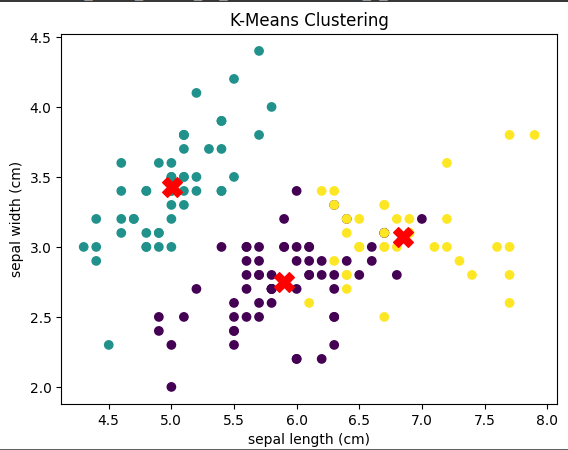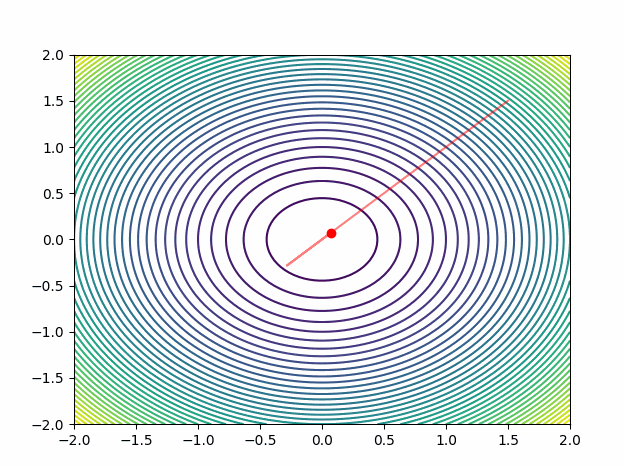printf("ho_tari\n");
ep.34 딥러닝개론8 본문
2024.8.23
머신러닝
linearregression.py
import numpy as np
import tensorflow as tf
from tensorflow.keras.models import Sequential
from tensorflow.keras.layers import Dense
# 데이터 생성
np.random.seed(0)
X = np.random.rand(100, 1) # 100개의 샘플, 1개의 feature
y = 3 * X + 2 + np.random.randn(100, 1) * 0.1 # y = 3x + 2 + 잡음
# 모델 정의
model = Sequential()
model.add(Dense(1, input_dim=1, activation='linear'))
# 모델 컴파일
model.compile(optimizer='sgd', loss='mse')
# 모델 학습
model.fit(X, y, epochs=100, verbose=1)
# 예측
pred = model.predict(X)
logisticregression.py
import numpy as np
import tensorflow as tf
from tensorflow.keras.models import Sequential
from tensorflow.keras.layers import Dense
# 데이터 생성
np.random.seed(0)
X = np.random.randn(100, 1)
y = (X > 0).astype(int) # 0 또는 1로 변환
# 모델 정의
model = Sequential()
model.add(Dense(1, input_dim=1, activation='sigmoid'))
# 모델 컴파일
model.compile(optimizer='sgd', loss='binary_crossentropy', metrics=['accuracy'])
# 모델 학습
model.fit(X, y, epochs=100, verbose=1)
# 예측
pred = model.predict(X)
force-L.py
import numpy as np
import gym
# 환경 설정 (OpenAI Gym의 FrozenLake 환경)
env = gym.make("FrozenLake-v1", is_slippery=False)
# Q-테이블 초기화
q_table = np.zeros([env.observation_space.n, env.action_space.n])
# 학습 파라미터
alpha = 0.8 # 학습률
gamma = 0.95 # 할인률
epsilon = 0.1 # 탐험(exploration) 확률
episodes = 1000
# Q-learning 알고리즘
for i in range(episodes):
state = env.reset()
# 만약 state가 튜플이면 첫 번째 값을 사용
if isinstance(state, tuple):
state = state[0]
done = False
while not done:
# 상태 값의 유효성 확인
if not (0 <= state < q_table.shape[0]):
print(f"Invalid state: {state}")
break
# ε-greedy 정책에 따라 행동 선택
if np.random.uniform(0, 1) < epsilon:
action = env.action_space.sample() # 무작위 행동 선택
else:
action = np.argmax(q_table[state]) # Q-값이 가장 큰 행동 선택
# 환경과 상호작용
next_state, reward, terminated, truncated, _ = env.step(action)
# 만약 next_state가 튜플이면 첫 번째 값을 사용
if isinstance(next_state, tuple):
next_state = next_state[0]
# Q-테이블 업데이트
q_table[state, action] = q_table[state, action] + alpha * (reward + gamma * np.max(q_table[next_state]) - q_table[state, action])
# 상태 업데이트
state = next_state
done = terminated or truncated # 에피소드 종료 조건
print("학습된 Q-테이블:")
print(q_table)
Supervised-L.py
from sklearn.datasets import load_iris
from sklearn.model_selection import train_test_split
from sklearn.neighbors import KNeighborsClassifier
from sklearn.metrics import accuracy_score
# 데이터 로드
iris = load_iris()
X, y = iris.data, iris.target
# 데이터셋 분리 (학습 데이터와 테스트 데이터)
X_train, X_test, y_train, y_test = train_test_split(X, y, test_size=0.3, random_state=42)
# K-최근접 이웃 분류기 (KNN) 모델 생성 및 학습
model = KNeighborsClassifier(n_neighbors=3)
model.fit(X_train, y_train)
# 예측 및 정확도 계산
y_pred = model.predict(X_test)
print(f'Accuracy: {accuracy_score(y_test, y_pred)}')
unsupervised.py
from sklearn.datasets import load_iris
from sklearn.cluster import KMeans
import matplotlib.pyplot as plt
import pandas as pd
# 데이터 로드
iris = load_iris()
X = iris.data
# K-Means 클러스터링 (k=3)
kmeans = KMeans(n_clusters=3, random_state=42)
y_kmeans = kmeans.fit_predict(X)
# 시각화 (두 개의 차원만 사용)
plt.scatter(X[:, 0], X[:, 1], c=y_kmeans, cmap='viridis')
plt.scatter(kmeans.cluster_centers_[:, 0], kmeans.cluster_centers_[:, 1], s=200, c='red', marker='X')
plt.xlabel(iris.feature_names[0])
plt.ylabel(iris.feature_names[1])
plt.title("K-Means Clustering")
plt.show()
PCA-classify.py
from sklearn.datasets import load_iris
from sklearn.model_selection import train_test_split
from sklearn.decomposition import PCA
from sklearn.neighbors import KNeighborsClassifier
from sklearn.metrics import accuracy_score, classification_report
# 데이터셋 로드
iris = load_iris()
X = iris.data
y = iris.target
# PCA로 차원 축소 (4차원 -> 2차원)
pca = PCA(n_components=2)
X_pca = pca.fit_transform(X)
# 데이터셋 분할 (80% 학습, 20% 테스트)
X_train, X_test, y_train, y_test = train_test_split(X_pca, y, test_size=0.2, random_state=42)
# KNN 분류 모델 정의 (k=3)
knn_classifier = KNeighborsClassifier(n_neighbors=3)
# 모델 학습
knn_classifier.fit(X_train, y_train)
# 예측
y_pred = knn_classifier.predict(X_test)
# 정확도 및 분류 보고서 출력
print("Accuracy:", accuracy_score(y_test, y_pred))
print("\nClassification Report:\n", classification_report(y_test, y_pred))
knn-classifier.py
from sklearn.datasets import load_iris
from sklearn.model_selection import train_test_split
from sklearn.neighbors import KNeighborsClassifier
from sklearn.metrics import accuracy_score, classification_report
# 데이터셋 로드
iris = load_iris()
X = iris.data
y = iris.target
# 데이터셋 분할 (80% 학습, 20% 테스트)
X_train, X_test, y_train, y_test = train_test_split(X, y, test_size=0.2, random_state=42)
# KNN 분류 모델 정의 (k=3)
knn_classifier = KNeighborsClassifier(n_neighbors=3)
# 모델 학습
knn_classifier.fit(X_train, y_train)
# 예측
y_pred = knn_classifier.predict(X_test)
# 정확도 및 분류 보고서 출력
print("Accuracy:", accuracy_score(y_test, y_pred))
print("\nClassification Report:\n", classification_report(y_test, y_pred))
tor-logisticregress.py
import torch
import torch.nn as nn
import torch.optim as optim
# 데이터 생성
torch.manual_seed(0)
X = torch.randn(100, 1)
y = (X > 0).float() # 0 또는 1로 변환
# 모델 정의
class LogisticRegressionModel(nn.Module):
def __init__(self):
super(LogisticRegressionModel, self).__init__()
self.linear = nn.Linear(1, 1)
def forward(self, x):
return torch.sigmoid(self.linear(x))
model = LogisticRegressionModel()
# 손실 함수와 옵티마이저 정의
criterion = nn.BCELoss()
optimizer = optim.SGD(model.parameters(), lr=0.01)
# 모델 학습
for epoch in range(100):
model.train()
# 예측값 계산
y_pred = model(X)
# 손실 계산
loss = criterion(y_pred, y)
# 역전파
optimizer.zero_grad()
loss.backward()
optimizer.step()
if (epoch + 1) % 10 == 0:
print(f'Epoch {epoch+1}, Loss: {loss.item()}')
# 예측
pred = model(X).detach().numpy()
knn-diabets.py
from sklearn.datasets import load_diabetes
from sklearn.model_selection import train_test_split
from sklearn.neighbors import KNeighborsRegressor
from sklearn.metrics import mean_squared_error, r2_score
# 데이터셋 로드
diabetes = load_diabetes()
X = diabetes.data
y = diabetes.target
# 데이터셋 분할 (80% 학습, 20% 테스트)
X_train, X_test, y_train, y_test = train_test_split(X, y, test_size=0.2, random_state=42)
# KNN 회귀 모델 정의 (k=5)
knn_regressor = KNeighborsRegressor(n_neighbors=5)
# 모델 학습
knn_regressor.fit(X_train, y_train)
# 예측
y_pred = knn_regressor.predict(X_test)
# MSE 및 R^2 점수 출력
print("Mean Squared Error:", mean_squared_error(y_test, y_pred))
print("R^2 Score:", r2_score(y_test, y_pred))
rmspropanimation.py
import numpy as np
import matplotlib.pyplot as plt
import matplotlib.animation as animation
# 최적화할 함수 (2D)
def func(x, y):
return x**2 + y**2
# 기울기 계산 (2D)
def gradient(x, y):
return 2*x, 2*y
# RMSprop 애니메이션
def rmsprop_animation():
fig, ax = plt.subplots()
x, y = np.meshgrid(np.linspace(-2, 2, 100), np.linspace(-2, 2, 100))
z = func(x, y)
ax.contour(x, y, z, levels=50)
# 초기 위치
pos = np.array([1.5, 1.5])
learning_rate = 0.1
decay_rate = 0.9
epsilon = 1e-8
# 기울기 제곱의 이동 평균
grad_squared_avg = np.zeros_like(pos)
point, = ax.plot([], [], 'ro')
path, = ax.plot([], [], 'r-', alpha=0.5)
positions = [pos.copy()]
def update(i):
nonlocal pos, grad_squared_avg
grad = np.array(gradient(pos[0], pos[1]))
# 기울기 제곱의 이동 평균 업데이트
grad_squared_avg = decay_rate * grad_squared_avg + (1 - decay_rate) * grad**2
# 학습률 조정
adjusted_lr = learning_rate / (np.sqrt(grad_squared_avg) + epsilon)
# 위치 업데이트
pos -= adjusted_lr * grad
positions.append(pos.copy())
# pos 값을 시퀀스로 전달
point.set_data([pos[0]], [pos[1]])
path.set_data(*zip(*positions))
return point, path
ani = animation.FuncAnimation(fig, update, frames=50, interval=200, blit=True)
ani.save('/content/rmsprop_animation.gif', writer='pillow')
plt.close()
from IPython.display import Image
return Image('/content/rmsprop_animation.gif')
# 애니메이션 실행
rmsprop_animation()
adamanimation.py
import numpy as np
import matplotlib.pyplot as plt
import matplotlib.animation as animation
# 최적화할 함수 (2D)
def func(x, y):
return x**2 + y**2
# 기울기 계산 (2D)
def gradient(x, y):
return 2*x, 2*y
# Adam 애니메이션
def adam_animation():
fig, ax = plt.subplots()
x, y = np.meshgrid(np.linspace(-2, 2, 100), np.linspace(-2, 2, 100))
z = func(x, y)
ax.contour(x, y, z, levels=50)
# 초기 위치
pos = np.array([1.5, 1.5])
learning_rate = 0.1
beta1 = 0.9 # 모멘텀을 위한 지수 평균 가중치
beta2 = 0.999 # 기울기 제곱의 지수 평균 가중치
epsilon = 1e-8 # 분모 안정화를 위한 작은 값
m = np.zeros_like(pos) # 모멘텀(1차 모멘트) 초기화
v = np.zeros_like(pos) # 스케일링(2차 모멘트) 초기화
t = 0 # 타임스텝
point, = ax.plot([], [], 'ro')
path, = ax.plot([], [], 'r-', alpha=0.5)
positions = [pos.copy()]
def update(i):
nonlocal pos, m, v, t
t += 1
grad = np.array(gradient(pos[0], pos[1]))
# 모멘텀과 스케일링 업데이트
m = beta1 * m + (1 - beta1) * grad
v = beta2 * v + (1 - beta2) * (grad ** 2)
# 편향 보정
m_hat = m / (1 - beta1**t)
v_hat = v / (1 - beta2**t)
# 위치 업데이트
pos -= learning_rate * m_hat / (np.sqrt(v_hat) + epsilon)
positions.append(pos.copy())
point.set_data([pos[0]], [pos[1]])
path.set_data(*zip(*positions))
return point, path
ani = animation.FuncAnimation(fig, update, frames=50, interval=200, blit=True)
ani.save('/content/adam_animation.gif', writer='pillow')
plt.close()
from IPython.display import Image
return Image('/content/adam_animation.gif')
# 애니메이션 실행
adam_animation()
adamgradanimation.py
import numpy as np
import matplotlib.pyplot as plt
import matplotlib.animation as animation
# 최적화할 함수 (2D)
def func(x, y):
return x**2 + y**2
# 기울기 계산 (2D)
def gradient(x, y):
return 2*x, 2*y
# Adagrad 애니메이션
def adagrad_animation():
fig, ax = plt.subplots()
x, y = np.meshgrid(np.linspace(-2, 2, 100), np.linspace(-2, 2, 100))
z = func(x, y)
ax.contour(x, y, z, levels=50)
# 초기 위치
pos = np.array([1.5, 1.5])
learning_rate = 1.0
epsilon = 1e-8
# 기울기 제곱 합 초기화
grad_squared_sum = np.zeros_like(pos)
point, = ax.plot([], [], 'ro')
path, = ax.plot([], [], 'r-', alpha=0.5)
positions = [pos.copy()]
def update(i):
nonlocal pos, grad_squared_sum
grad = np.array(gradient(pos[0], pos[1]))
# 기울기 제곱 합 업데이트
grad_squared_sum += grad**2
# 학습률 조정
adjusted_lr = learning_rate / (np.sqrt(grad_squared_sum) + epsilon)
# 위치 업데이트
pos -= adjusted_lr * grad
positions.append(pos.copy())
# pos 값을 시퀀스로 전달
point.set_data([pos[0]], [pos[1]])
path.set_data(*zip(*positions))
return point, path
ani = animation.FuncAnimation(fig, update, frames=50, interval=200, blit=True)
ani.save('/content/adamgrad_animation.gif', writer='pillow')
plt.close()
from IPython.display import Image
return Image('/content/adamgrad_animation.gif')
# 애니메이션 실행
adagrad_animation() DR-01408_박성호_딥러닝개론_8차시_수업내용.ipynb
1.17MB
DR-01408_박성호_딥러닝개론_8차시.ipynb
0.05MB
DR-01408_박성호_딥러닝개론_8차시_수업내용.ipynb
1.17MB
DR-01408_박성호_딥러닝개론_8차시.ipynb
0.05MB
'(두산로보틱스) ROKEY 부트 캠프 > Computer Vision 교육' 카테고리의 다른 글
| ep.36 OpenCV2 (0) | 2024.08.27 |
|---|---|
| ep.35 OpenCV1 (0) | 2024.08.26 |
| ep.33 딥러닝개론7 (0) | 2024.08.22 |
| ep.32 딥러닝개론6 (0) | 2024.08.21 |
| ep.31 딥러닝개론5 (0) | 2024.08.20 |



